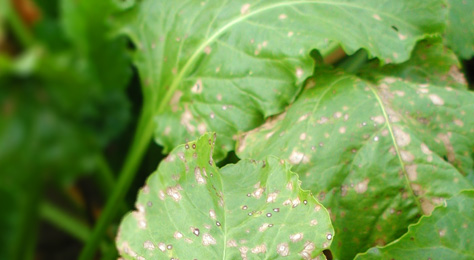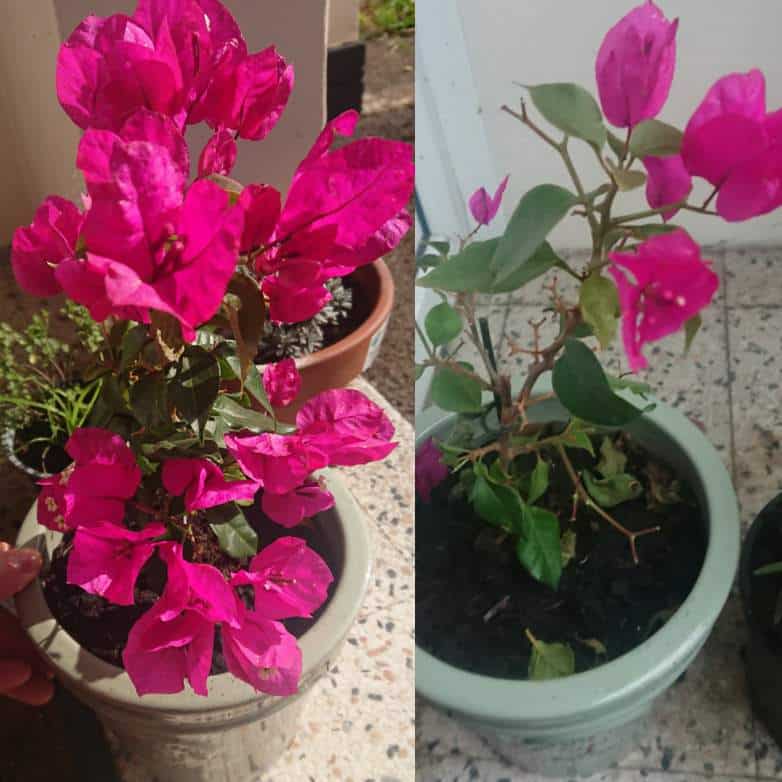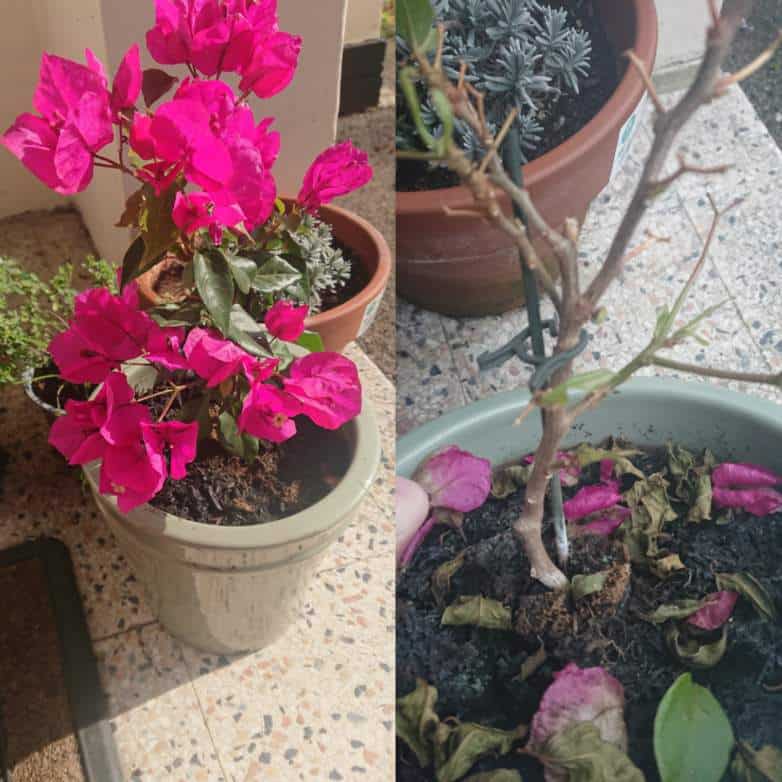
Overwatering, poorly draining soils, and cold weather are common causes of dying bougainvilleas. A dying bougainvillea results from overwatering because it traps too much moisture around its roots, which leads to leaf drop and root rot. Bougainvillea dies when it is regularly colder than 40°F (5°C).
Due to transplant shock or because they are not in full sun, bougainvilleas may also lose their leaves soon after being planted.
Continue reading to learn more about the causes of your bougainvillea’s demise and how to treat it to bring it back to life.
Table of Contents
Over Watering Bougainvillea Causes Root Rot
Your bougainvillea is most likely dying as a result of overwatering.
Native to arid regions of South America, bougainvilleas are drought-resistant plants that do well in gardens that mimic those harsh environments.
A bougainvillea will often exhibit stress symptoms like leaf drop and a lack of blossoms if it is overwatered. Overwatering on a regular basis can even create root rot, which is frequently the reason why bougainvilleas die.
Leaf drop is sometimes misinterpreted by gardeners as an indication that the bougainvillea needs more water, which exacerbates the issue.
You are almost likely overwatering your bougainvillea if you are watering it more frequently than once per week.
Bougainvilleas prefer moist soil, so only water them when the earth has slightly dried out since you last watered them or after a rainstorm to prevent the soil from becoming damp.
It is crucial to water your bougainvillea according to the environment and weather conditions since how much water you should give your bougainvillea depends on a number of factors, including climate, rainfall, sunlight intensity, how quickly the soil drains, etc.
To test if there is any moisture present, probe the earth surrounding the bougainvillea to a depth of a few fingers.
In order to stimulate the roots to grow and establish in the soil, which further boosts the plant’s hardiness and drought tolerance, if the soil feels moist, delay watering for a few days until it feels more dry, and then give the plant a generous soak (rather than a light watering).
When planted in ideal well-draining soil and there hasn’t been much rain, bougainvilleas typically thrive when watered once every two weeks.
This is especially true for bougainvilleas that have been planted in pots since they get the ideal amount of moisture to grow while also giving the soil time to dry up so the roots don’t succumb to water stress.
But I must stress again how crucial it is to water plants appropriately for the conditions. Established bougainvilleas frequently don’t need any additional water in locations with abundant rainfall.
Reduce watering to once every two weeks if your bougainvillea is dying or losing leaves, and only water if it hasn’t rained much recently.
Assuming the bougainvillea is only experiencing water stress, it should begin to recover over the next few weeks (if the weather is warm and it is in full sun).
This depends on whether the bougainvillea is planted in a pot with drainage holes or in soil that drains properly.
But if the bougainvillea is left in wet soil for too long, it could develop root rot and eventually perish.
(Read my post Why is my bougainvillea not flowering if your bougainvillea has a lot of foliage but isn’t blooming.)
Slow Draining Soils (Bougainvillea Requires Good Drainage)

A bougainvillea should ideally be planted in soil that has a combination of organic matter (compost and leaf mold) and some inorganic material (horticultural sand or grit) to improve the soil’s drainage and aeration and to mimic the ideal soil conditions in the plant’s natural environment.
When planted in slow-draining soil, such as thick clay or naturally swampy places, where water may collect around the roots and produce water stress, bougainvilleas do not thrive well.
The first sign of a bougainvillea in distress owing to slow draining soils is leaf drop, even in warm or mild conditions. These signs are the same as those of overwatering (leaves can also drop due to cold).
How to fix it
- I would strongly advise against growing bougainvillea in clay soils if at all feasible because it won’t likely survive for very long.
- Because of the better drainage conditions, it is recommended to plant bougainvillea in pots, containers, or raised beds in gardens with a lot of clay or naturally soggy places. Additionally, it is considerably simpler to alter the soil profile to meet the needs of bougainvillea.
- Move the bougainvillea urgently to a pot or a drier part of the garden if the soil is constantly wet (due to slow drainage). When digging, always use a fork rather than a spade or shovel to protect the bougainvillea’s rather fragile roots.
- With plenty of drainage holes in the base and a potting mix that contains about 80% multipurpose compost and 20% horticultural sand or grit to assist drainage, pick a pot that is 12 to 16 inches wide.
Before transplanting bougainvillea, there are a few excellent practices to be aware of, therefore I suggest watching this useful YouTube video first:
However, a larger pot or container has the capacity for more soil, which helps to insulate the cold sensitive roots in cooler climates, so a relatively large pot or container is often a better choice. Bougainvilleas actually tolerate having their roots pot bound, and it is even correlated with more flowering (roots stress can encourage flowering).
More sand or grit should be added to the potting mix in regions with greater rainfall levels so that the roots can dry more quickly and avoid root rot.
If the bougainvillea is too big to move, I advise making channels in the soil with a fork and filling them with sand (preferably using a funnel) to alter the soil profile, enhance the soil structure, and promote drainage.
This method can help your bougainvillea’s drainage and keep it from dying, and it can be surprisingly successful.
More sand, grit, or perlite in the soil helps to promote drainage to counteract the water in cooler, heavier rainfall conditions to prevent root rot or water stress.
(See my article on how to water potted bougainvillea.)
Bougainvillea Leaf and Flower Drop due to Cold Temperatures
In South America’s hot, sunny, and arid regions, bougainvillea is a natural plant. Consequently, it is relatively sensitive to cold (hardy in USDA zones 9).
The bougainvillea may lose its leaves as an indication of stress if you live in a colder environment or have an unseasonably cold spell (with a sharp change in temperature).
The vibrant bracts that surround the blooms and are actually specialized leaves may also wilt or fall off in response to the cold.
While some varieties can even endure a mild frost and come back strong when the weather heats up, certain varieties do tolerate cold better than others.
Remember that bougainvilleas can actually be deciduous in cooler locations (and evergreen in warmer regions that are similar to their original temperature), so leaf drop is not always a cause for alarm or a warning that the plant is in danger of dying.
A little frost on bougainvillea is likely to cause some of the leaves and flowers to fall off, as well as perhaps cause the branches to die.
However, because the roots are protected by the soil, the older, harder wood and the most cold-sensitive element of the plant, the leaves, frequently survive.
The bougainvillea is probably not going to come back if there is a particularly severe frost or very cold weather for an extended period of time.
The ideal method for cultivating bougainvilleas in cold climates is to plant them in pots, bring them inside as soon as the nighttime low falls below 40°F (5°C), and set the pot in a sunny window to keep the bougainvillea from becoming ill or dying from the cold.
Water your bougainvillea plant about once every 4-6 weeks if you want to move it inside for the winter.
Instead of near a source of heat or in the line of air currents, place the bougainvillea in a space that preferably has a temperature that is generally constant, such as a garage, heated greenhouse, or possibly the kitchen because temperature fluctuations can stress the plant.
The next Spring, when the nighttime temperature is consistently over 40°F (5°C), plant the bougainvillea outdoors in broad light.
Not Enough Sun– Dying Bougainvillea
Bougainvilleas thrive in the full sun in their natural habitat.
The bougainvillea’s health and lifespan are strongly associated with the amount of sunlight it receives, and this component also determines how many flowers it can produce.
For bougainvilleas to flourish and produce flowers in the spring and summer, they need at least 6 hours of direct sunlight each day. Bougainvilleas typically have less remarkable growth, fewer flowers, and a shorter lifespan if they are in too much shadow.
The drier circumstances to which bougainvillea are acclimated naturally are helped to be created by increased evaporation for the nearby soil caused by direct sunlight.
If your bougainvillea is not receiving direct sunlight, you may either thin out any overhanging trees that may be casting shade or prune back any nearby plants to let in more light.
The bougainvillea can also be moved, if at all possible, to a place with more sunlight.
Your bougainvillea should ideally be in a pot or container that can be moved easily into full light.
In a few weeks, the bougainvillea should start to recover if you relocate it to a sunny part of your garden, but if you leave it there for too long, it might not be able to recover.
(View my article on potted bougainvillea growth.)
Dying After Planting (Transplant Shock)

Commercially grown bougainvilleas can be grown in tightly controlled greenhouse environments with constant temperatures, ideal sunlight and watering, and the roots can become used to the soil conditions when they are grown for sale in garden centers.
The bougainvillea may become less resilient and more susceptible to changes in the weather under such regular settings.
– Leaf drop. … Remember that bougainvillea can actually be deciduous in cooler climes (and evergreen in warmer regions that are similar to their natural temperature), so leaf drop is not always a cause for alarm or a warning that the plant is in danger.
There is a good chance that parts of the leaves, flowers, and perhaps even the branches will drop off bougainvillea if it receives a light frost.
But because the roots are protected by the soil, the older, harder wood and the roots, which are the plant’s most vulnerable to cold, frequently survive.
The likelihood of the bougainvillea not reviving is increased if there is a particularly severe frost or prolonged cold temperatures.
- The ideal method for growing bougainvilleas in cold areas is to plant them in pots and bring them inside as soon as the temperature at night falls below 40°F (5°C) (and place the pot in a sunny window) to avoid the bougainvillea suffering from the cold or dying.
- Water your bougainvillea pot perhaps once every 4-6 weeks if you plan to keep it indoors throughout the winter.
- Instead of near a source of heat or in the line of air currents, place the bougainvillea in a space with ideally a temperature that is pretty constant, such as a garage, heated greenhouse, or possibly the kitchen. This is because the plant can become stressed by temperature fluctuations.
- When the nighttime temperature is consistently above 40°F (5°C) in the spring, plant the bougainvillea outdoors in broad light.
Boainvilleas enjoy full sun in their natural habitat.
The bougainvillea’s health and lifespan are directly associated with its ability to produce a certain number of flowers, and the amount of sunshine is the single most crucial factor in determining both of those things.
Key Takeaways:
- For bougainvilleas to flourish and produce flowers in the spring and summer, they need at least six hours of direct sunlight daily. Bougainvilleas typically have less remarkable growth, fewer flowers, and a lesser likelihood of surviving for a very long time if they are in excessive shadow.
- The drier circumstances to which bougainvillea are acclimated naturally are facilitated by increased evaporation for the surrounding soil from direct sunlight.
- If your bougainvillea is not receiving direct sunlight, you may either thin out any overhanging trees that may be throwing shade or prune back any nearby plants to allow more light to reach your bougainvillea.
- The bougainvillea might also be moved, ideally to a spot with more sunlight.
- A bougainvillea in a pot or container that can be moved quickly into full sun is ideal.
In a few weeks, the bougainvillea should start to show symptoms of recovery if you relocate it to a sunny part of your garden. However, if you leave it in the shade for an extended period of time, it might be hard to recover.
